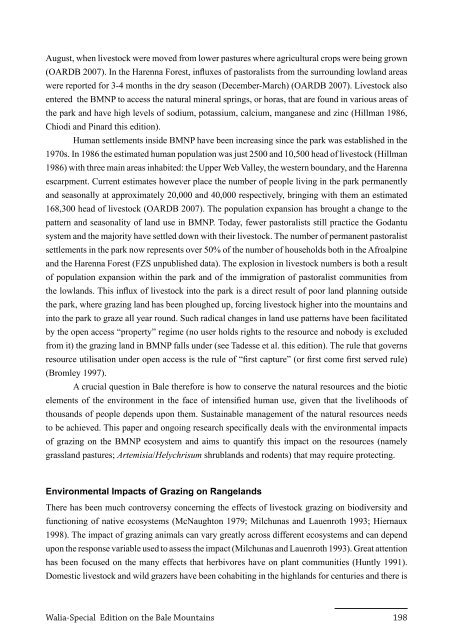Walia Special Edition on the Bale Mountains (2011) - Zoologische ...
Walia Special Edition on the Bale Mountains (2011) - Zoologische ...
Walia Special Edition on the Bale Mountains (2011) - Zoologische ...
Create successful ePaper yourself
Turn your PDF publications into a flip-book with our unique Google optimized e-Paper software.
August, when livestock were moved from lower pastures where agricultural crops were being grown<br />
(OARDB 2007). In <strong>the</strong> Harenna Forest, influxes of pastoralists from <strong>the</strong> surrounding lowland areas<br />
were reported for 3-4 m<strong>on</strong>ths in <strong>the</strong> dry seas<strong>on</strong> (December-March) (OARDB 2007). Livestock also<br />
entered <strong>the</strong> BMNP to access <strong>the</strong> natural mineral springs, or horas, that are found in various areas of<br />
<strong>the</strong> park and have high levels of sodium, potassium, calcium, manganese and zinc (Hillman 1986,<br />
Chiodi and Pinard this editi<strong>on</strong>).<br />
Human settlements inside BMNP have been increasing since <strong>the</strong> park was established in <strong>the</strong><br />
1970s. In 1986 <strong>the</strong> estimated human populati<strong>on</strong> was just 2500 and 10,500 head of livestock (Hillman<br />
1986) with three main areas inhabited: <strong>the</strong> Upper Web Valley, <strong>the</strong> western boundary, and <strong>the</strong> Harenna<br />
escarpment. Current estimates however place <strong>the</strong> number of people living in <strong>the</strong> park permanently<br />
and seas<strong>on</strong>ally at approximately 20,000 and 40,000 respectively, bringing with <strong>the</strong>m an estimated<br />
168,300 head of livestock (OARDB 2007). The populati<strong>on</strong> expansi<strong>on</strong> has brought a change to <strong>the</strong><br />
pattern and seas<strong>on</strong>ality of land use in BMNP. Today, fewer pastoralists still practice <strong>the</strong> Godantu<br />
system and <strong>the</strong> majority have settled down with <strong>the</strong>ir livestock. The number of permanent pastoralist<br />
settlements in <strong>the</strong> park now represents over 50% of <strong>the</strong> number of households both in <strong>the</strong> Afroalpine<br />
and <strong>the</strong> Harenna Forest (FZS unpublished data). The explosi<strong>on</strong> in livestock numbers is both a result<br />
of populati<strong>on</strong> expansi<strong>on</strong> within <strong>the</strong> park and of <strong>the</strong> immigrati<strong>on</strong> of pastoralist communities from<br />
<strong>the</strong> lowlands. This influx of livestock into <strong>the</strong> park is a direct result of poor land planning outside<br />
<strong>the</strong> park, where grazing land has been ploughed up, forcing livestock higher into <strong>the</strong> mountains and<br />
into <strong>the</strong> park to graze all year round. Such radical changes in land use patterns have been facilitated<br />
by <strong>the</strong> open access “property” regime (no user holds rights to <strong>the</strong> resource and nobody is excluded<br />
from it) <strong>the</strong> grazing land in BMNP falls under (see Tadesse et al. this editi<strong>on</strong>). The rule that governs<br />
resource utilisati<strong>on</strong> under open access is <strong>the</strong> rule of “first capture” (or first come first served rule)<br />
(Bromley 1997).<br />
A crucial questi<strong>on</strong> in <strong>Bale</strong> <strong>the</strong>refore is how to c<strong>on</strong>serve <strong>the</strong> natural resources and <strong>the</strong> biotic<br />
elements of <strong>the</strong> envir<strong>on</strong>ment in <strong>the</strong> face of intensified human use, given that <strong>the</strong> livelihoods of<br />
thousands of people depends up<strong>on</strong> <strong>the</strong>m. Sustainable management of <strong>the</strong> natural resources needs<br />
to be achieved. This paper and <strong>on</strong>going research specifically deals with <strong>the</strong> envir<strong>on</strong>mental impacts<br />
of grazing <strong>on</strong> <strong>the</strong> BMNP ecosystem and aims to quantify this impact <strong>on</strong> <strong>the</strong> resources (namely<br />
grassland pastures; Artemisia/Helychrisum shrublands and rodents) that may require protecting.<br />
Envir<strong>on</strong>mental Impacts of Grazing <strong>on</strong> Rangelands<br />
There has been much c<strong>on</strong>troversy c<strong>on</strong>cerning <strong>the</strong> effects of livestock grazing <strong>on</strong> biodiversity and<br />
functi<strong>on</strong>ing of native ecosystems (McNaught<strong>on</strong> 1979; Milchunas and Lauenroth 1993; Hiernaux<br />
1998). The impact of grazing animals can vary greatly across different ecosystems and can depend<br />
up<strong>on</strong> <strong>the</strong> resp<strong>on</strong>se variable used to assess <strong>the</strong> impact (Milchunas and Lauenroth 1993). Great attenti<strong>on</strong><br />
has been focused <strong>on</strong> <strong>the</strong> many effects that herbivores have <strong>on</strong> plant communities (Huntly 1991).<br />
Domestic livestock and wild grazers have been cohabiting in <strong>the</strong> highlands for centuries and <strong>the</strong>re is<br />
<str<strong>on</strong>g>Walia</str<strong>on</strong>g>-<str<strong>on</strong>g>Special</str<strong>on</strong>g> <str<strong>on</strong>g>Editi<strong>on</strong></str<strong>on</strong>g> <strong>on</strong> <strong>the</strong> <strong>Bale</strong> <strong>Mountains</strong> 198
















